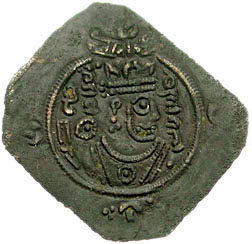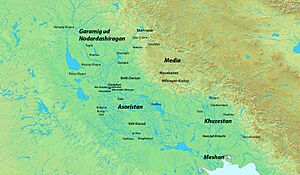Shahrbaraz facts for kids
Quick facts for kids Shahrbaraz |
|
|---|---|
| King of Kings of Iran and non-Iran | |
 |
|
| Shahanshah of the Sasanian Empire | |
| Reign | 27 April 630 – 9 June 630 |
| Predecessor | Ardashir III |
| Successor | |
| Died | 9 June 630 Ctesiphon |
| Spouse | Mirhran |
| Issue |
|
| House | House of Mihran |
| Father | Ardashir |
| Religion | Zoroastrianism |
Shahrbaraz (also called Shahrvaraz) was a powerful general who became the king (or shah) of the Sasanian Empire for a short time. He ruled from April 27 to June 9 in the year 630. He took the throne from Ardashir III and was killed by Iranian nobles after only 40 days. Before becoming king, he was a top general, known as a spahbed, under King Khosrow II. Shahrbaraz played a very important role in the big war between the Sasanian Empire and the Byzantine Empire from 602 to 628.
Contents
What's in a Name?
The name Shahrbaraz is actually a title. It means "the Boar of the Empire." This name showed how skilled he was as a military leader and how brave he was in battle. The boar was a symbol of victory in the ancient Zoroastrian religion. His real name was Farrukhan.
Early Life and Family
Shahrbaraz was part of an important noble family called the House of Mihran. His father was named Ardashir. Shahrbaraz joined the Sasanian army and quickly rose through the ranks. He became a spahbed, a high-ranking general.
He married Mirhran, who was the sister of King Khosrow II. They had a son named Shapur-i Shahrvaraz. Shahrbaraz also had another son named Niketas the Persian.
Great War Against the Byzantine Empire
Shahrbaraz first became famous during the last and longest war between the Sasanian and Byzantine Empires. This war lasted 26 years.
- In 604, Khosrow II, along with Shahrbaraz and other generals, captured important cities like Dara and Edessa.
- By 610, a new Byzantine Emperor, Heraclius, took power. He tried to fight back.
- In 613, Shahrbaraz led the Sasanian army to a huge victory against Heraclius near Antioch. This win gave the Sasanians control of the city and access to the Mediterranean Sea.
After this, Shahrbaraz continued to defeat Byzantine armies in Syria. He captured Damascus and took many Byzantine soldiers as prisoners. He also won a battle near Adhri'at.
One of his most important achievements was leading the Sasanian army to capture Jerusalem in 614. This city was very holy to Christians. After the conquest, the True Cross, a sacred Christian relic, was taken away as a prize.
- In 618, Khosrow II ordered Shahrbaraz to invade Egypt. By 619, the Sasanian army had captured Alexandria, the capital of Byzantine Egypt.
- By 621, the Sasanians fully controlled Egypt.
In 622, Emperor Heraclius launched a counter-attack in Anatolia. Shahrbaraz was sent to stop him but was defeated. Heraclius then moved his army into the Caucasus region. Shahrbaraz, along with other Sasanian generals, tried to trap Heraclius's forces. However, Heraclius was very skilled. He defeated the Sasanian armies one by one.
In February 625, Heraclius launched a surprise night attack on Shahrbaraz's camp. Shahrbaraz barely escaped, losing his belongings and many men. Later, there were more battles, including one near the Sarus River. Shahrbaraz tried to trick Heraclius, but Heraclius bravely charged across a bridge, turning the battle around. Shahrbaraz was so impressed that he said Heraclius feared arrows no more than an anvil!
Siege of Constantinople
Shahrbaraz later took a smaller army and moved towards Chalcedon. This was a Sasanian base right across the Bosphorus strait from Constantinople, the capital of the Byzantine Empire. King Khosrow II had planned a combined attack on Constantinople with the Avars. Shahrbaraz's army was on the Asian side, while the Avars attacked from the European side.
However, the Byzantine navy controlled the Bosphorus. This meant Shahrbaraz could not send his troops to help the Avars. This made the siege less effective. Also, the Sasanians and Avars had trouble communicating across the water.
On August 7, 626, Byzantine ships destroyed a fleet of Sasanian rafts trying to cross the Bosphorus. The Avar attacks on the city walls also failed. When news arrived that another Sasanian general, Shahin, had been defeated, the Avars gave up and retreated. Even though Shahrbaraz's army was still at Chalcedon, the threat to Constantinople was over.
King Khosrow II was very disappointed with Shahrbaraz's failure. He sent a secret letter to Kardarigan, Shahrbaraz's second-in-command. The letter ordered Kardarigan to kill Shahrbaraz and bring the army back. But Byzantine soldiers captured the messengers and gave the letter to Emperor Heraclius.
Heraclius showed the letter to Shahrbaraz. After reading it, Shahrbaraz decided to switch sides and join Heraclius. He then changed the letter to say that Khosrow II wanted 400 officers killed. This made Kardarigan and the rest of the army stay loyal to Shahrbaraz. Shahrbaraz then moved his army to northern Syria. This way, he could choose to support either Khosrow or Heraclius. By neutralizing Shahrbaraz, Heraclius weakened his enemy and secured his own path to invade Iran.
Overthrowing King Khosrow II
In 627, Khosrow ordered Shahrbaraz to send his army to the capital, Ctesiphon. But Shahrbaraz refused. Instead, he moved his army to another region. Khosrow sent a negotiator, Farrukhzad, but Farrukhzad secretly joined Shahrbaraz.
One year later, in 628, powerful noble families in the Sasanian Empire were tired of the long war and Khosrow's harsh rule. They freed Khosrow's son, Sheroe, who had been imprisoned. These families included Shahrbaraz, representing his own family, and other important leaders.
In February, Sheroe and his allies captured Ctesiphon and imprisoned Khosrow II. Sheroe then declared himself king, taking the name Kavadh II. He had all his brothers killed, including Khosrow II's favorite son. Three days later, he ordered his father, Khosrow II, to be executed.
Kavadh II then made peace with Emperor Heraclius. The Byzantines got back all their lost lands, their captured soldiers, and the Holy Cross. They also received money for the war.
After losing so much land, the Sasanian Empire started to break apart. Different noble families formed their own independent states. Dams and canals were neglected, and a terrible plague hit the western parts of Iran. This plague killed half the population, including Kavadh II. His young son, Ardashir III, became the new king.
Becoming King
After Kavadh II died, Emperor Heraclius sent a letter to Shahrbaraz. He told Shahrbaraz that the throne was now his and that he would send troops if needed.
On April 27, 630, Shahrbaraz attacked Ctesiphon with 6,000 soldiers. He couldn't capture the city at first. So, he made alliances with two powerful figures: Piruz Khosrow and Namdar Gushnasp. With their help, Shahrbaraz captured Ctesiphon. He then executed the young king Ardashir III and many other nobles.
Shahrbaraz became the new king of the Sasanian Empire. He also killed Kardarigan, who had opposed him. Heraclius even recognized Shahrbaraz's Christian son, Niketas, as his heir. This opened up the possibility of Christianity spreading in Iran.
However, Shahrbaraz's reign was very short. Forty days later, on June 9, 630, during a ceremony, Shahrbaraz was killed by a javelin thrown by Farrukh Hormizd. Farrukh Hormizd then helped Boran, the daughter of Khosrow II, become the new queen.
His Impact and Legacy
Shahrbaraz played a huge role in the war against the Byzantines and the events that followed. His decision to go against Khosrow II led to a civil war within the Sasanian Empire.
After Shahrbaraz's death, his son Shapur-i Shahrvaraz briefly became king but was soon removed by the nobles. Shahrbaraz's other son, Niketas, later served the Byzantines as a general.
Stories about Shahrbaraz's bravery and adventures became popular later on. His story even influenced famous tales like One Thousand and One Nights.
See also
 In Spanish: Sharvaraz para niños
In Spanish: Sharvaraz para niños




